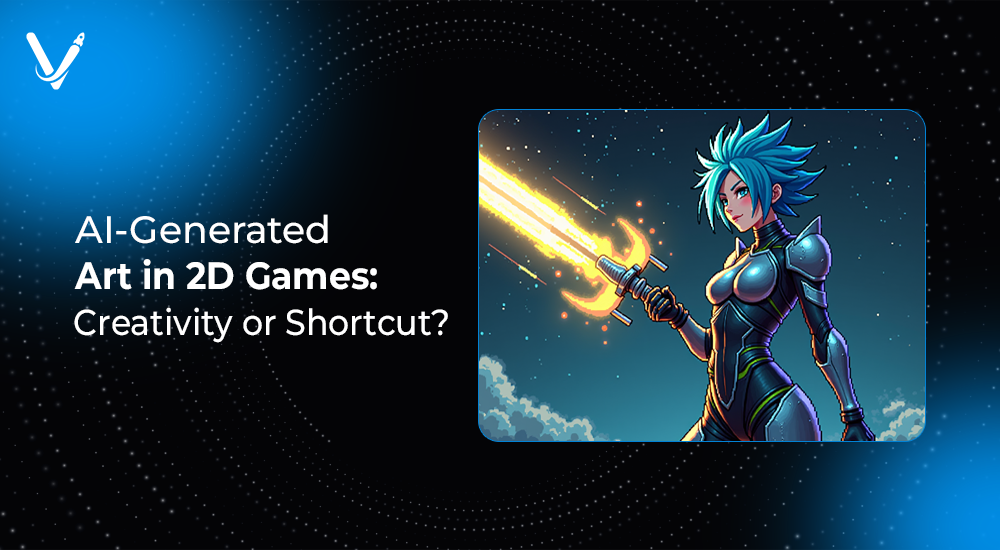AI-Generated Art in 2D Games: Creativity or Shortcut?


- Jun 16, 2025



In the vibrant world of 2D games, visuals shape imagination, dictate mood, and carry storytelling weight. Artists traditionally crafted these visuals by hand, pixel by pixel, creating intricate characters, lush environments, and unique interfaces that defined each game’s identity. This craftsmanship made games like Hollow Knight, Celeste, and Cuphead stand out not only for gameplay but also for their artistic brilliance.
Now, artificial intelligence is emerging as a powerful tool in the hands of creators. With tools like DALL·E, Midjourney, and Stable Diffusion, artists can generate polished visuals using simple prompts. But this power comes with a dilemma: Is AI-generated art an enabler of creativity or a shortcut that undercuts it? This blog explores the rise of AI in 2D game development, examining its impact on creativity, workflow, ethics, and the future of visual design.
AI-generated art leverages machine learning models to create visual content based on large datasets. These models are trained on thousands—or even millions—of images to understand styles, structures, color palettes, and object forms.
In the context of 2D game development, AI art tools can produce:
Advanced tools allow for fine-tuning via style transfer or custom model training, ensuring the AI can replicate a studio’s preferred aesthetic.
Technologies behind this revolution include:
The result? Artists and developers can go from concept to visual output in minutes instead of days.
The traditional asset pipeline in 2D game design involves brainstorming, sketching, coloring, and revisions. AI tools can cut down the timeline dramatically. A detailed background scene that may take a week by hand can be prototyped within minutes using AI, allowing teams to allocate more time to gameplay refinement or level design.
Hiring professional artists or outsourcing artwork can be costly for indie developers or startups. AI-generated assets offer a cost-effective alternative, especially during early-stage development or when visual quality can be iterated over time.
AI allows developers to explore multiple visual styles rapidly. Want to see your world in a vaporwave aesthetic or retro pixel form? Prompt the AI, and it delivers options that might inspire entirely new design directions.
Developers can generate multiple versions of a character or scene and immediately evaluate them within the game context. This speeds up decision-making and reduces creative friction between design and development teams.
Developed by Steve Kups, this experiment in generative game development used Midjourney and DALL·E to generate every asset—enemies, environments, UI elements. While the visuals varied in consistency, the project demonstrated how AI can support full-cycle asset creation in solo or small-team projects.
A unique narrative game using AI-generated portraits and prompts, designed to evoke surreal emotions. It showcased how AI can create atmospheric art with emotional ambiguity, blending visual storytelling and procedural generation.
AAA studios are experimenting with tools like Promethean AI, which helps concept artists populate scenes by generating draft visuals from verbal descriptions. This is becoming a powerful assistant in level design and world-building phases.
By removing the tedium of repetitive tasks, AI tools free artists to focus on higher-level ideas like mood, storytelling, and layout. Artists can use AI to prototype multiple concepts, mash up art styles, or experiment with surreal ideas that might take too long to draw manually.
Some use cases include:
Despite its advantages, AI art can risk flattening the creative landscape. Overreliance may lead to:
Games that rely purely on AI art without refinement can feel disconnected, missing the artistic soul that draws players into rich, emotional worlds.
Many AI models are trained on publicly scraped images, including artworks under copyright. This raises concerns around derivative work, fair use, and the legality of using AI-generated visuals in commercial games.
Artists have raised alarms about models that replicate their unique styles without permission. The question arises: should artists be credited or compensated if their work helped train the model?
While not legally required yet, disclosing AI involvement in game art is becoming an ethical standard. Transparency helps maintain player trust and encourages dialogue around responsible use.
In traditional 2D asset workflows, each asset goes through:
With AI tools, the pipeline looks more like:
This reduces the number of production stages while opening up real-time creative feedback loops. Teams can work in parallel on levels, mechanics, and UI without waiting for final art.
Looking forward, AI will evolve into a real-time creative assistant:
Rather than eliminate human input, AI will augment the artist’s palette, providing new tools for faster, richer, and more adaptive game worlds.
Studios that learn to blend AI efficiency with human emotion and story will lead the next generation of 2D gaming innovation.
AI-generated art doesn’t replace the artist—it empowers them. When used with intention and care, it acts as a creative catalyst, unlocking faster iteration, lower costs, and more diverse visual exploration. But when misused or over-relied upon, it risks producing soulless, indistinct visuals.
The key lies in balance.
At Vasundhara Infotech, we specialize in leveraging modern tools while honoring timeless creativity. Our expert teams work with AI art and custom illustration to help game developers create captivating 2D worlds that connect with players. Ready to take your visuals to the next level?
Let’s build something extraordinary together. Contact us today.
Copyright © 2025 Vasundhara Infotech. All Rights Reserved.